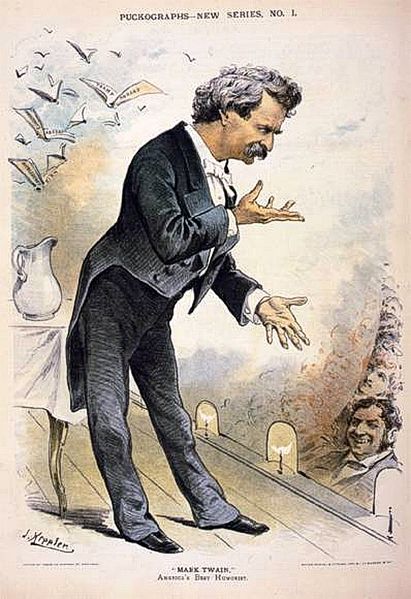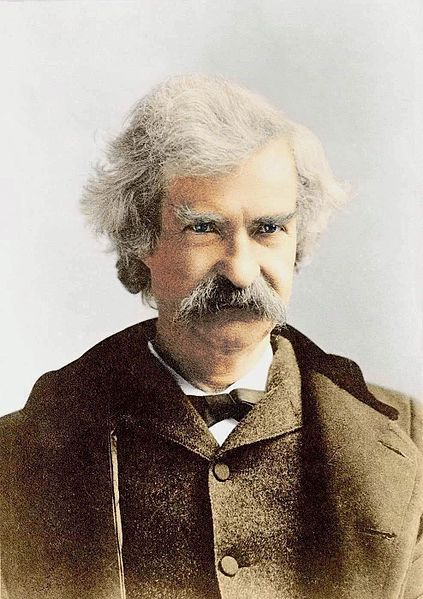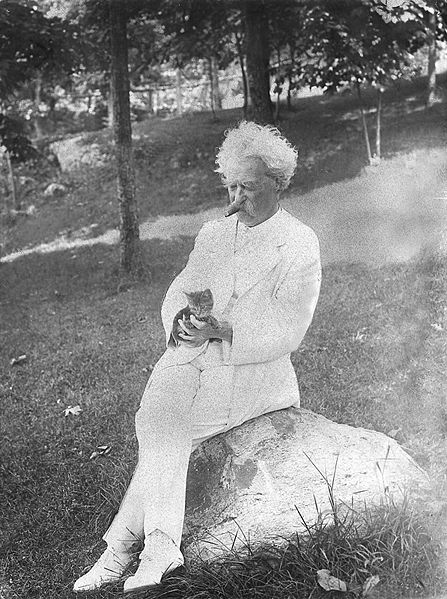
Many Thai students of English are assigned Mark Twain’s Adventures of Huckleberry Finn to study in class, since it is commonly considered one of America’s greatest novels.
Still, in many ways it is an odd choice for non-native English readers today. It includes much slang and writing down of unusual accented speech that can make the book difficult to understand even for British or American readers. It is often misunderstood as a children’s story, like The Adventures of Tom Sawyer which precedes it. Instead, Huckleberry Finn has many serious points to make about the sufferings of African-Americans during the time of slavery. Yet its language which reproduces the speech of Americans before the Civil War is often seen as offensive today, and some American libraries have even tried to ban the book for this reason.
The name Huckleberry itself is strange, since it is not really a name at all, but a kind of fruit, as a variation on the hurtleberry or whortleberry, both a kind of bilberry. Students of plant life will know that the name huckleberry is usually applied to the Gaylussacia and Vaccinium species. Set in Missouri on the Mississippi River, Huckleberry Finn was criticized by many readers, including Louisa May Alcott, author of another popular novel, Little Women. Alcott complained that if Twain could not think of something better to tell our pure-minded lads and lasses he had best stop writing for them. Another celebrated novelist, Ernest Hemingway, pointed to the book’s weak last chapter, in which the novel devolves into little more than minstrel-show satire and broad comedy. Even so, Hemingway praised Huckleberry Finn as the best book we’ve had. Not worrying about such concerns, Hollywood has adapted Huckleberry Finn dozens of times, including a 1993 film starring Elijah Wood and Huckleberry Finn Monogatari, a 26-episode 1994 Japanese anime.

Mark Twain’s wit.
Although Mark Twain was a bestselling author, his sense of humor could be too rude for readers of his time. In 1880 he anonymously published a story written four years earlier, 1601: Conversation, as it was by the Social Fireside, in the Time of the Tudors. He only admitted writing this story in 1906 because it was considered so scandalous that no reputable writer of the day would want to be associated with it. This story has been included in some anthologies of Twain’s writings, which are not in the collection of the TU LIbraries, but which may be obtained by inter-library loan. 1601 is presented as part of a diary of one of Queen Elizabeth I’s ladies-in-waiting, and is supposed to reproduce a conversation between Elizabeth I and celebrated writers of her time. The Elizabethan era was noted for the rude behaviour that went on, and yet English readers greatly admire such Elizabethan writers as William Shakespeare. Mark Twain decided to make fun of this apparent contradiction by having the British palace conversation he presented be entirely about impolite matters such as stomach gas. Twain writes in a mock-Elizabethan spelling which can be as difficult to read as the dialogue in Huckleberry Finn:
In ye heat of ye talk it exceed yt one did breake wind, yielding an exceeding mightie and distresfull stink, whereat all did laugh full sore.
While typical of Twain, this type of joke can seem a little dated today, even for those who can read and understand the words.
Mark Twain and Thailand
Perhaps unexpectedly, Twain also had a link to Thailand. In 1869 he wrote a short comic sketch, Personal Habits of the Siamese Twins, inspired by the heavy press coverage in America of Chang and Eng Bunker. In and Chun (1811-1874), conjoined twins born in the Mae Klong Valley, Samut Songkhram Province, Siam during the reign of King Rama II, took on the names Chang and Eng Bunker and eventually settled in North Carolina, USA. There they continued to attract the attention of journalists such as the Memphis Tennessee Public Ledger which reproduced an article in 1869 from the London Star, Surgical Examination of the Siamese
Twins, quoting Sir James Simpson, Professor of Medicine and Midwifery at the University of Edinburgh, who had examined the twins, and published his conclusions in the British Medical Journal:
When infants they were attached face to face, but instinctive efforts from the earliest age have so far elongated the band as to enable them to adopt an imperfect lateral relation to each other. They are short, but wiry-looking men: Eng, the taller of the two, being only five feet two and a half inches, Chang, an inch shorter. They use the outer more than inner legs, by standing and these are the larger in circumference…They can walk, swim and run; they are keen sportsmen and good shots; intelligent, well informed, and good men of business. They are naturally much accustomed to join in the same conversation, but can each easily carry on a conversation with two different individuals. They sometimes read separately, each to himself; more often one aloud to the other. Their minds, indeed, are more dual, than their bodies; the latter are united together, but the former are not.
The specialist from Edinburgh concluded that while Chang and Eng showed no desire to be surgically separated, some members of their families thought it might be a good idea. The doctor felt that separating them would be harmful for their minds, more than for their bodies.
Mocking this expert’s authoritative statements, Mark Twain wrote Personal Habits of the Siamese Twins which first appeared in the same year, 1869:
The Siamese Twins are naturally tender and affectionate in disposition, and have clung to each other with singular fidelity throughout a long and eventful life. Even as children they were inseparable companions; and it was noticed that they always seemed to prefer each other’s society to that of any other persons. They nearly always played together; and, so accustomed was their mother to this peculiarity, that, whenever both of them chance to be lost, she usually only hunted for one of them — satisfied that when she found that one she would find his brother somewhere in the immediate neighborhood.
Twain continues to make fun of the idea of brothers who cannot separate from one another even if they wished to:
As men, the Twins have not always lived in perfect accord; but, still, there has always been a bond between them which made them unwilling to go away from each other and dwell apart. They have even occupied the same house, as a general thing, and it is believed that they have never failed to even sleep together on any night since they were born. How surely do the habits of a lifetime become second nature to us! The Twins always go to bed at the same time; but Chang usually gets up about an hour before his brother. By an understanding between themselves, Chang does all the in-door work and Eng runs all the errands. This is because Eng likes to go out; Chang’s habits are sedentary. However, Chang always goes along. Eng is a Baptist, but Chang is a Roman Catholic; still, to please his brother, Chang consented to be baptized at the same time that Eng was, on condition that it should not “count.” During the War they were strong partisans, and both fought gallantly all through the great struggle–Eng on the Union side and Chang on the Confederate.
All of the above is strictly untrue of course, making up part of Twain’s attempt at absurd humor, which concludes after discussing the twins’ marital history and supposed drinking habits:
Having forgotten to mention it sooner, I will remark, in conclusion, that the ages of the Siamese Twins are respectively fifty-one and fifty-three years.
As it happened, Twain often wrote about twins in his novels, so he was genuinely intrigued by the twinship of Chang and Eng Bunker, but expressed his fascination with his typical derisory wit.

(all images courtesy of Wikimedia Commons)

